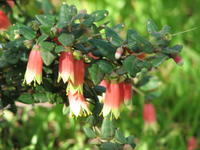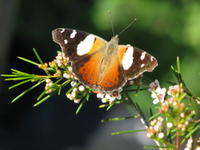I have been trying for several days to capture a
New Holland Honeyeater doing their usual gymnastic tricks while feeding. Just before lunch today I managed to get one upside down feeding from a flower in an
Eremophila youngii. Eremophilas are commonly called Emu Bushes.

No - I haven't inserted the photograph upside down! It's the bird that is upside down. The curved beaks of the Ausralian honeyeaters are ideally suited to feeding from many of the Australian plants like the Eremophilas, Correas and Prostantheras with their tube shaped flowers.

Of course the
New Holland Honeyeaters don't have it all to themselves. The
Red Wattlebirds also insist on their fair share of the spoils. The above photo shows a Red Wattlebird busy in another eremophila nearby. A few seconds after this photo was taken a New Holland Honeyeater tried to chase the wattlebird away, only to have the tables turned and become the one being chased.

Wattlebirds can be bossy creatures, especially if another bird tries to muscle in on their patch of food. The above photo shows a rare moment in the life of a Red Wattlebird - sitting peacefully on a branch of a
Eucalyptus citriodora or Lemon Scented Gum. On closer inspection of the photo I just realised that this individual is keeping the above eremophila plant under surveillance.

My new interest in butterflies continues unabated. I didn't realise how many butterflies we have around our garden until I started quietly stalking them, camera poised. Today I managed several reasonable shots of the
Vanessa kershawi or the
Australian Painted Lady butterfly. We have at least two other species common in our garden, but I have yet to get a good shot of them. I know of at least two other species that have visited in the past but I haven't seen them for several years.
Here's another challenge I could set myself. Try to get some photos of the dragonflies we have around here! Then I could move on to other insects, such as ants and beetles. And what about caterpillars? Oh, and then we have quite a selection of reptiles, including Brown Snakes (which are very dangerous so I don't want to get too close; the zoom lens will help there).

As for lizards, they are on the move already. I have included a photo taken yesterday of a Stumpy-Tailed Lizard (also called a Shingleback). We have quite a few individuals on our little estate. I haven't seen any young Stumpy-Tails for a few months. We did see several in the autumn months. We enjoy seeing them come to one of the bird baths for a drink. The Aussie expression "flat out like a lizard drinking" is so apt. To illustrate how common this species is in the Murray Bridge area, our local poetry competition is called "The Stumpies". I'll try to get a link to details of this award.
We also have a range of geckoes and skinks on our land, all of them quite beautifully marked and would make wonderful photographs to include in this journal. Then we have the following mammals present (or occasional visitors): Western Grey Kangaroo, Common Brushtail Possum, Short-Beaked Echidna, Brown Hare*, European Rabbit*, House Mouse*, Black Rat*, Red Fox* and feral cat*(*introduced). I am sure we probably also have four or five species of bats but I've only indentified the Western Broad-Nosed Bat.
Mmmm... methinks I've opened a can of worms here!
Worms???
How photogenic are worms??
PS. I'm so pleased I do not have to buy film for this new camera.
 Of course, the camera was in the house, so I tried to casually walk into the house hoping that the ringneck would stay there. It didn't but flew to a tree some 50 metres away. I continued working, all the time watching for the bird to return. I didn't have to wait long. It settled in a tree near the house. I quietly went inside with the camera, planning to use our sun-room as a hide. We have three bird baths about six metres from a large picture window. We have had hundreds of very enjoyable meals watching the parade of birds coming to drink or bathe. Again, a very "good" waste of time, being very relaxing and enjoyable.
Of course, the camera was in the house, so I tried to casually walk into the house hoping that the ringneck would stay there. It didn't but flew to a tree some 50 metres away. I continued working, all the time watching for the bird to return. I didn't have to wait long. It settled in a tree near the house. I quietly went inside with the camera, planning to use our sun-room as a hide. We have three bird baths about six metres from a large picture window. We have had hundreds of very enjoyable meals watching the parade of birds coming to drink or bathe. Again, a very "good" waste of time, being very relaxing and enjoyable. Today's visitor was taking quite a deal of interest in the water. After taking some good photos through the window I decided to go outside and see how close I could get to the ringneck. I was able to get to about 3 metres away while the bird came down to the bird-bath and proceed to have a very thorough bath. I managed to get several more excellent photos. I then pressed the video button on the camera and filmed the bird washing and preening for about two minutes. I haven't yet worked out whether I can make this video available on this blog.
Today's visitor was taking quite a deal of interest in the water. After taking some good photos through the window I decided to go outside and see how close I could get to the ringneck. I was able to get to about 3 metres away while the bird came down to the bird-bath and proceed to have a very thorough bath. I managed to get several more excellent photos. I then pressed the video button on the camera and filmed the bird washing and preening for about two minutes. I haven't yet worked out whether I can make this video available on this blog. Usually we have only two Australian Ringnecks around in the garden. In recent months there have been four, two of them juveniles. They aren't in our garden constantly but rather roam over a wide range of the local environment. We usually love seeing them near to the house like today. When they decide to raid the orchard and nip the buds off the pear and apple trees we get just a tad annoyed - no - angry. We also get no fruit! Today I observed only one bird; I wonder if the other is nesting somewhere?
Usually we have only two Australian Ringnecks around in the garden. In recent months there have been four, two of them juveniles. They aren't in our garden constantly but rather roam over a wide range of the local environment. We usually love seeing them near to the house like today. When they decide to raid the orchard and nip the buds off the pear and apple trees we get just a tad annoyed - no - angry. We also get no fruit! Today I observed only one bird; I wonder if the other is nesting somewhere?






























